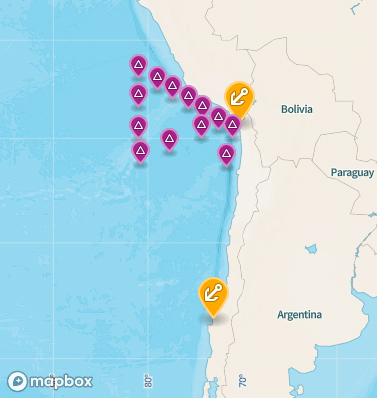2023 Nitrite Oxidation in Oxygen Minimum Zones
Investigating the apparent oxidation of nitrite in the absence of oxygen on a research cruise to the low oxygen waters off the coast of Peru
This research is grounded in the fundamental role of nitrogen in limiting production in the ocean. Nitrite oxidation by nitrite oxidizing bacteria (NOB) is the only known biological process that produces nitrate, which comprises the largest fixed nitrogen reservoir in the ocean, and all known NOB require oxygen for life. The reduction pathway is also carried out by microbes, in this case, bacteria that thrive only in the absence of oxygen. Despite their apparent incompatibility regarding oxygen, both processes are detected in the low oxygen or anoxic waters of oxygen minimum zones (OMZs). Thus, the fate of nitrite in OMZs has implications for the global fixed N budget.
The scientists will investigate three explanations for the apparent oxidation of nitrite in the absence of oxygen on a research cruise to the low oxygen waters off the coast of Peru:
- The presence of unknown kinds of NOB that do not require oxygen
- A new reaction called dismutation, which is possible but never detected in nature
- An artifact associated with oxygen stress in NOB
These questions will be addressed by performing a suite of 15N-tracer incubations at stations located within and outside of one of the major OMZs in the ocean, the Eastern Tropical South Pacific. Multiple oxygen sensors will be mounted to the CTD during casts and net tows to collect plankton will be performed.
This research could lead to discovery of novel mechanisms and/or novel organisms that determine the fate of nitrite and the availability of nitrogen to support primary production in the long run. This project will advance discovery and understanding while promoting teaching, training and learning by providing opportunities for Princeton students to have hands-on experience in research in the lab and at sea. Both undergraduate and graduate students will participate in the research through internships and field experiences. We will also integrate our work at sea into teaching in the classroom via videos and assignments based on data collected during the cruise.
GO-BGC will deploy 5 biogeochemical (BGC) Argo profiling floats at 5 locations along the Revelle RR2310 cruise track, as part of growth the global arrays. Each float carries the standard (core) Argo sensors (temperature and salinity), and sensors for oxygen, nitrate, pH, fluorescence and backscatter. The floats will drift at 1000 m depth, and will profile from approximately 2000 m to the sea surface every 10 days. At each BGC Argo float deployment there will be hydrographic station work, as part of the main hydrographic work being carried out by the Chief Scientist’s party. On each CTD/rosette profile, rosette bottles will be sampled for nutrients, pH/TA, HPLC/POC, salinity, and possibly oxygen depending on science party capability. Data from the floats will be available in near real-time to the public.
-
- Five GO-BGC float deployments that measure biogeochemical properties in addition to measuring the temperature and salinity of seawater
- Deployment of 18 Argo floats (S2A model) along the cruise tracks already planned on the Revelle.
The cruise will depart Talcahuano, Chile November 18, 2023 on the R/V Roger Revelle and arrive in Arica, Chile on December 20, 2023.
Chief Scientist: Bess Ward (Princeton University)

Figure 1: Sampling stations for Nitrite Oxidation in Oxygen Minimum Zones
